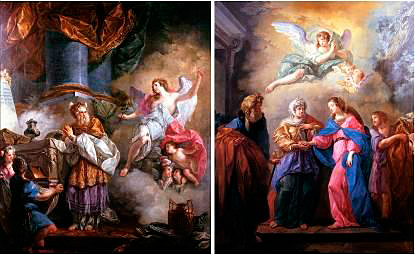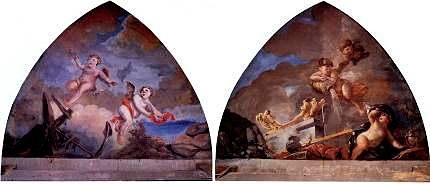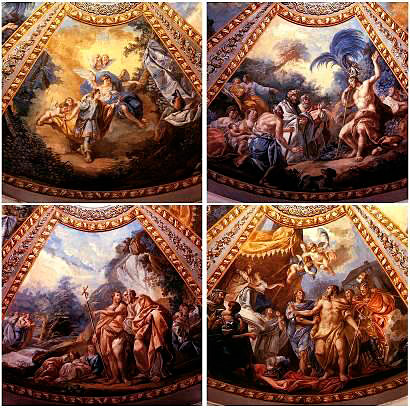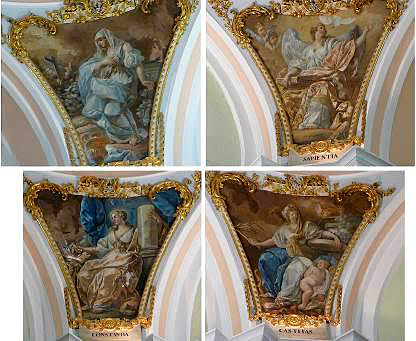25 September
Global Seminars & Invited Speaker Series
VIANA ON ITS VIII CENTENARY: CULTURE AND HERITAGE
The chapel of San Juan del Ramo and the paintings of Paret
José Javier Azanza López
University of Navarra
Between 1785 and 1787, the Madrid painter Luis Paret y Alcázar (1746-1799) executed a group of paintings dedicated to the exaltation of Saint John the Baptist for the chapel of San Juan del Ramo, built by Francisco Oteiza between 1781-1784 on the site of the former chapel of San Francisco de Asís, in the north aisle of the parish church of Santa María de Viana.
As soon as the architectural work on the chapel was completed, contact with the artist must have begun. He was the chaplain of honour of the Royal Chapel of the Palace, royal preacher and confessor to Queen Maria Luisa of Parma; his intervention was decisive in enabling Paret to reconcile his workin Viana with the royal commission received in July 1786 to paint the Cantabrian ports, which almost cost him the failure of projectand led to its passing into the hands of the Cascantino painter Diego Díaz del Valle, who had experience in mural painting.
The work of the painter from Madrid, who was then established in Bilbao after being released from his Puerto Rican exile, included two oil canvases that he personally transferred from the Biscayan capital in February 1787, and the tempera decoration of the antechapel and chapel (averageorange and pendentives), to which he devoted the summer of the same year, travelling to the Navarrese city and most probably staying in the stately Urra house at placede San Miguel. designHe also took special care in the decorative work in the chapel, from the gilding and stucco details to the furniture such as benches and even the pedestal on which the Gothic image of Saint John was to rest. The Madrid painter's connection with the Viana parish did not end with the pictorial work, as once he had settled in Madrid in the 1790s, he was asked to design a tabernacle, three Holy Thursday monuments, altar tables and silver pieces.
The artist's correspondence with the parish of Viana, twelve autograph letters exhumed by Juan Cruz Labeaga (the great scholar of this collection) covering the period from September 1785 to February 1787, is samplerich in details both of the paintings and of the artist's life staff, which constantly reaffirms his desire to "serve with my limited talents" and "to please as far as my strength will allow". Also preserved are the royal licenceauthorising the painter to work in Viana, the receipts for the payments for the paintings, in which Paret shows his selflessness ("I show my desire to serve you rather than to earn"), and the general plan in which the painter explains each scene and its meaning, revealing his profound biblical, allegorical and symbolic knowledge.
The two oil canvases (figure 1) represent the advertisement of the angel to Zacharias and the Visitation of the Virgin to Saint Elizabeth, which Juan Anonio Gaya Nuño assesses as follows: "The extraordinary colour spread in the paintings can be summed up by saying that in the two canvases blue and green dominate; presiding over a lavish range of chromatisms, with a joy of colour in itself, with sufficient primors for the pair of paintings to be regarded with special respect, for what they have of balance between the Venetians and Delacroix".

Luis Paret. Canvases of the advertisement of the Angel to Zechariah and the Visitation of the Virgin to St. Elizabeth.
In the first of these, the old priest is dressed in the ornaments typical of Jewish priests; his face is beautiful and dignified, and his hands "are among the most expressive and best painted in Spanish painting", in Gaya Nuño's own opinion. The painter himself expressed his satisfaction with the final result: "It is very much to my taste and to that of all intelligent amateurs; it is one of the best I have done".
In the second, the oblique figure of "the most beautiful angel in 18th-century Spanish painting", according to Javier González de Durana, adds dynamism to the verticality and stagnation of the figures. Two preparatory drawings are in the BNE, one of which depicts a Bust of a Man (a Turk?) ( ca. 1786-1787) with a long beard, dressed in a fur-trimmed caftan and wearing a turban and jewelled headdress, which seems to be related to the figure of Zacharias, although Alejandro Martínez does not rule out the possibility that it is an independent work, as the clothing and headdress are more typical of a contemporary Turkish or Old Russian figure.
The tempera decoration (an exceptional technique in Paret's production) begins in the antechapel, with two allegorical scenes featuring angels bearing attributes symbolising the passage from the Old to the New Alliance. Manuela Mena does not hesitate to relate them to the two lunette canvases in the Museo de Bellas Artes in Bilbao under the title Triumph of Love over War ( degree scroll ): "These tempera paintings, with scenes of little angels with the relevant symbols, reveal the same technique of execution and child models very close in their attitudes and games, as well as in their physiognomies, to those of the two lunettes of profane subject matter in the Bilbao Museum" (fig. 2).

Luis Paret. Allegorical scenes of the passage from the Old to the New Covenant.
This is not the only parallel that Mena draws between the Viana ensemble and the Bilbao paintings, as we read at purposeabout the decoration of the dome: "In the paintings in the church in Navarre, the artist used a powerful technique, with energetic brushstrokes applied with confidence, which in some areas show a verge of violence, although without ever losing control of the form. This technique is evidently designed to achieve the desired effect in large figures, with abundant clothing and decorative folds, which must be seen from a distance. The same way of painting is the one Paret had used in the lunettes of the Bilbao Museum a year earlier, employee, which were also intended to be seen from afar. The painter himself had already warned of this circumstance when he stated that "all the figures in these stories of the orange averagewill be taller than their natural height, as the distance demands it".
Four episodes from the life of the Baptist are depicted on the helmets of the orange average(figure 3). The first, sample, depicts the Baptist "who, from his tender years sectionof his parents' house, went to live in the desert", explains Paret. Labeaga notes the elegance of the young man's clothing and footwear "in little consonance with the desert, but which betrays Paret's fondness for luxury". The presence of the bread and wine has given rise to different interpretations by historians, from symbol of penitence to rejection of temptation. The second depicts the preaching of the Baptist, in a setting of luxuriant vegetation in which the Michelangeloesque echoes of the Sistine Chapel coexist (the half-naked beggar is a transcript of an ignudi, with echoes also in "Venus in the Forge of Vulcan", one of the tapestries with a mythological theme that decorates the walls of the sumptuous salon of Charles III dining before his court, ca. 1775), with the popularism of the popularist style. 1775), with the popularism of the extreme feminine group: "from these women to the Goyaesque manolas is only one step", Labeaga asserts.

Luis Paret. Scenes from the life of Saint John the Baptist on the orange average.
The third scene depicts the Baptist instructing Saint Andrew about the coming of the Messiah, "whom the saint, seeing him from afar, knew without having seen him before, saying: Ecce Agnus Dei", Paret describes. The Museo Nacional del Prado has two preparatory drawings for this scene and the previous one, the only two known to date programs of studyfor these works. The fourth and last one depicts the Arrest of the Baptist, a scene which, although tragic, gives a sense of luxury due to its rich, brilliant colouring and the decorative details evident in the carpet, canopy and helmet of the Roman warrior. The Herculean body of Saint John sampleresembles the Michelangeloesque Christ of the Last Judgement, just as one of the figures on the far left is a Sibylline transcript: "In turning to Michelangelo, our painter confesses a criterion: he considers the frescoes of the Sistine Chapel to be the archetype of mural decoration", says Osiris Delgado.
"I have resolved to demonstrate on the four pendentives the principal virtues and object of the Precursor's preaching and martyrdom, so that they may serve as a base or support for the orange average", Paret meant. Indeed, Holiness, Evangelical Wisdom, Constancy and Chastity are the four pillars on which St John the Baptist based his work of proclaiming the Messiah (figure 4). In them, Paret reflects the knowledgeof 17th-century French engravings, sometimes closer to the pagan than to the religious.

Luis Paret. The four virtues of the Precursor in the pendentives.
Holiness is depicted as a female figure with her head covered by a veil and kneeling before a cross; at her feet is a ewer and behind her is a flaming altar. The Evangelical Wisdom is a winged female figure elevated on a cubic block who receives the inspiration of the Holy Spirit in the form of a dove and holds the Book of Wisdom in her right hand, while another rests at her feet. Constancy is seated framed by an elegant blue drapery, holding a sword in her right hand over a flaming cauldron and embracing a pillar with her left. Finally, Chastity is a beautiful young woman seated beside an altar consecrated to Vesta, gesturing to punish with a scourge the blindfolded Cupid at her feet, as well as the bow and quiver; she holds in her right hand a sieve or sieve not to be poured out as a symbol of marital chastity.
The Museo Nacional del Prado has the preparatory drawings of the four pendentives, in the form of a cut trapezoid, with slight variations with respect to the final result. In the allegorical representation of the virtues with their corresponding attributes, Paret evidences the knowledgeof Cesare Ripa's Iconologia ( a work that formed part of his Library Services, as well as the Dictionaire iconologique by the French jurist Honoré Lacombe de Prezel, published in Paris in 1756), closely following the descriptions of the Italian humanist.
We conclude this brief survey of Paret's paintings in Viana by pointing out a point made by Manuela Mena that reveals the taste for decorative motifs that always animated the painter's production: "In all the paintings in the chapel of the church of Viana, Paret introduced flowers as a decorative motif that enlivens the scenes or adorns the figures' hair, especially roses. They do not seem to interest him for their symbolism or iconography, but for their aesthetic appeal [...] In the lunettes in the museum, however, Paret gave the flowers a specific meaning and prominence, especially the roses, which indicate his associationwith the two child figures and a meaning related to the triumph of Love that they both embody.
Such is the Vianese painting of Luis Paret, the most rococo of Spanish artists, "the sparkling and iridescent Paret" in the words of José Milicua, an exquisite author of refined compositions without parallel in Spanish art and at the same time a prelude to the popular costumbrismo of Goya, who knew how to adapt, when required, to academic tastes and even showed pre-Romantic traits. staffA scholar, polyglot and cosmopolitan, a painter who mastered drawing, colour and light, an exceptional draughtsman ("the most creative and creative of all the draughtsmen of his century", in the words of Alfonso E. Pérez Sánchez), illustrator, planner and designer of furniture and theatrical costumes with a great humanistic trainingand receptive to the influences of ancient and modern art, of all of which he left one of his best testimonies in the city of Navarre.
bibliography
DELGADO, O., Paret y Alcázar, Madrid, Universities of Puerto Rico and Madrid and CSIC, 1957.
GAYA NUÑO, J. A., "Luis Paret y Alcázar", bulletin de la Sociedad Española de Excursiones, 56, 1952, pp. 87-153.
LABEAGA MENDIOLA, J. C., Viana Monumental y Artística, Pamplona, Government of Navarra, 1984.
LABEAGA MENDIOLA, J. C., La obra de Luis Paret en Santa María de Viana, Pamplona, Government of Navarra, 1990.
LABEAGA MENDIOLA, J. C., "Luis Paret y Alcázar en el País Vasco y Navarra", in Luis Paret y Alcázar. 1746-1799, Vitoria-Gasteiz, Servicio Central de Publicaciones del Gobierno Vasco, 1991, pp. 79-111.
LABEAGA MENDIOLA, J. C., "Las pinturas de Luis Paret en Viana", in El arte en Navarra, t. II, Pamplona, Diario de Navarra, 1994, pp. 545-560.
LUNA, J. J., "Luis Paret y Alcázar", in Luis Paret y Alcázar. 1746-1799, Vitoria-Gasteiz, Servicio Central de Publicaciones del Gobierno Vasco, 1991, pp. 21-58.
MARTÍNEZ PÉREZ, A., Dibujos de Luis Paret, 1746-1799. Catalog razonado, Madrid, Centro de programs of study Europa Hispánica, 2018.
MENA MARQUÉS, M. B., "Luis Paret y Alcázar. El triunfo del Amor", in Luis Paret y Alcázar [1746-1749]. The Triumph of Love over War. Alicia Koplowitz Donation, Bilbao, Bilbao Fine Arts Museum, 2018, pp. 6-33.
MILICUA, J., "A Landscape by Luis Paret," Goya. Revista de Arte, 20, 1957, pp. 126-127.
MORALES Y MARÍN, J. L., Luis Paret. Life and work, Zaragoza, Aneto, 1997.
PÉREZ SÁNCHEZ, A. E., Catalog de Dibujos, III. Spanish Drawings. Siglo XVIII, Madrid, Museo del Prado and board of trustees Nacional de Museos, 1977.
RIPA, C., Iconology, Madrid, Akal, 1996.
